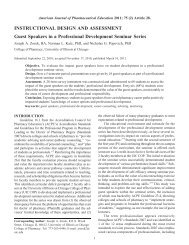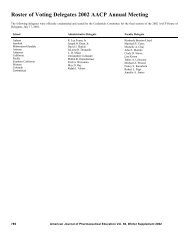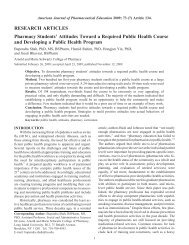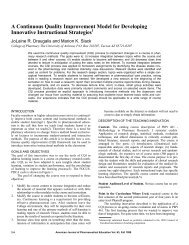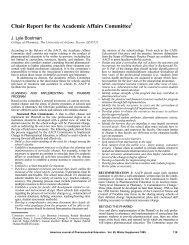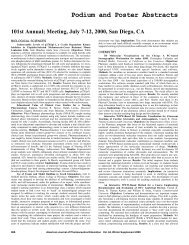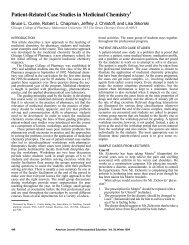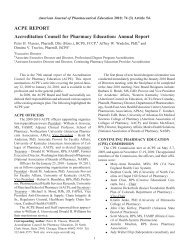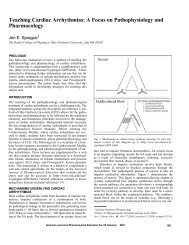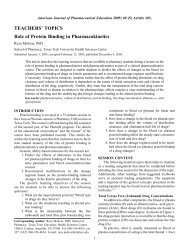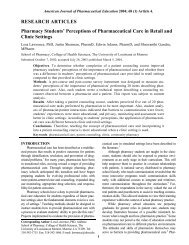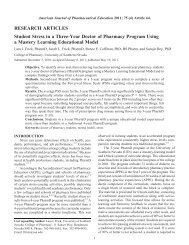Assessing Writing Perceptions and Practices of Pharmacy ... - AJPE
Assessing Writing Perceptions and Practices of Pharmacy ... - AJPE
Assessing Writing Perceptions and Practices of Pharmacy ... - AJPE
Create successful ePaper yourself
Turn your PDF publications into a flip-book with our unique Google optimized e-Paper software.
<strong>Assessing</strong> <strong>Writing</strong> <strong>Perceptions</strong> <strong>and</strong> <strong>Practices</strong> <strong>of</strong> <strong>Pharmacy</strong><br />
Students 1<br />
Paul L. Ranelli<br />
School <strong>of</strong> <strong>Pharmacy</strong>, University <strong>of</strong> Wyoming, P.O. Box 3375, Laramie WY82071-3375<br />
Jane V. Nelson<br />
Center for Teaching Excellence, University <strong>of</strong> Wyoming, Laramie WY 82017-3375<br />
This study aims to assess the writing perceptions <strong>and</strong> practices <strong>of</strong> pharmacy students. In fall 1996, an<br />
anonymous survey <strong>of</strong> writing self-assessment was administered to 45 second-year pharmacy students in<br />
a public health course. Students rated their confidence to communicate successfully for nine specific tasks<br />
<strong>and</strong> to perform 21 writing mechanic skills using a 0-100 scale, where 0 = no chance <strong>and</strong> 100 = completely<br />
certain. Students also indicated the importance <strong>of</strong> writing in pharmacy practice using a 0-100 scale, where<br />
0 = not important at all <strong>and</strong> 100 = extremely important. To assess improvement in ability to write position<br />
papers, the first <strong>and</strong> third essays <strong>of</strong> each student were assessed by a panel <strong>of</strong> six readers using a holistic<br />
scoring procedure, where 1 = weakest <strong>and</strong> 6 = strongest. <strong>Writing</strong> ability was the mean <strong>of</strong> each student’s<br />
scores on the two position papers. Composite communication confidence <strong>and</strong> mechanics confidence<br />
scores were calculated as the overall mean <strong>of</strong> all items in the respective categories; simple regression<br />
models were tested using these variables individually as predictors <strong>of</strong> students’ writing ability. The composite<br />
communication confidence score was 73.2 percent, <strong>and</strong> the composite mechanics confidence<br />
score was 79.0 percent. Students rated writing skills in pharmacy practice as important (75.4 percent).<br />
Communication confidence <strong>and</strong> mechanics confidence were significantly correlated with writing ability (r<br />
= 0.334 <strong>and</strong> 0.419, respectively) <strong>and</strong> with each other (r = 0.847). Communication confidence explained 11<br />
percent <strong>of</strong> the variance in writing ability, <strong>and</strong> mechanics confidence explained 18 percent. <strong>Writing</strong> scores<br />
significantly improved by a mean <strong>of</strong> 0.60 (SD = 1.13) on the second paper. These findings suggest some<br />
strategies for teachers to use in writing-intensive courses. A self-confidence survey given at the beginning<br />
<strong>of</strong> a course can be a productive diagnostic <strong>and</strong> learning tool. In their responses to student writing, teachers<br />
can focus less on correcting surface errors <strong>and</strong> more on issues <strong>of</strong> critical thinking, use <strong>of</strong> evidence,<br />
<strong>and</strong> the nature <strong>of</strong> disciplinary conventions. Finally, teachers can be confident that a writing-intensive<br />
course does make a positive difference in students’ ability to improve their writing.<br />
INTRODUCTION<br />
The movement <strong>of</strong> the pharmacy pr<strong>of</strong>ession from a product-based<br />
model to an information-based model has<br />
brought communication skills to the forefront <strong>of</strong> pharmacy<br />
education. Much emphasis has been placed on students’<br />
oral counseling skills in both clinical <strong>and</strong> administrative<br />
pharmacy coursework, <strong>and</strong> students at most schools have<br />
the opportunity to participate in the Patient Counseling<br />
Competition sponsored by the U.S. Pharmacopeia <strong>and</strong> the<br />
American Pharmaceutical Association. Few pharmacy<br />
educators have placed the same emphasis on writing skills,<br />
even though pharmacists in all practice settings have many<br />
1 Support for this research was provided by the University <strong>of</strong> Wyoming’s<br />
Center for Teaching Excellence <strong>and</strong> School <strong>of</strong> <strong>Pharmacy</strong>.<br />
426 American Journal <strong>of</strong> Pharmaceutical Education Vol. 62, Winter 1998
opportunities <strong>and</strong> responsibilities that involve writing,<br />
such as writing letters <strong>of</strong> recommendation, annual performance<br />
evaluations, letters to the editor, articles for publication,<br />
or proposals for new clinical services(1-4). Indeed,<br />
writing is a major component <strong>of</strong> some job descriptions for<br />
pharmacists, like those in drug information, administration,<br />
<strong>and</strong> pharmacy journalism. We believe that writing<br />
should be incorporated into pharmacy curricula as an integral<br />
part <strong>of</strong> pharmacy education, both for the immediate<br />
purpose <strong>of</strong> learning course material <strong>and</strong> for the long-range<br />
purpose <strong>of</strong> becoming a pr<strong>of</strong>essional.<br />
As a step in evaluating the importance <strong>of</strong> writing in<br />
<strong>and</strong> to the pr<strong>of</strong>ession, this study aims to assess the writing<br />
perceptions <strong>and</strong> practices <strong>of</strong> pharmacy students. Early in<br />
the fall semester, 1996, we administered an anonymous<br />
survey <strong>of</strong> writing self-assessment to second-year pharmacy<br />
students in a required public health course. We then<br />
checked features <strong>of</strong> writing that students completed early<br />
in the semester against these self-assessments. After the<br />
course concluded, we tested for improvement in writing<br />
by comparing two similar writing assignments, one written<br />
early in the course <strong>and</strong> one written near the end. With our<br />
study, we show the relationship between writing self-confidence<br />
<strong>and</strong> writing ability, <strong>and</strong> we also demonstrate that<br />
students can improve their writing as a result <strong>of</strong> experiencing<br />
a writing-intensive course.<br />
WRITING IN THE DISCIPLINES<br />
When this study was conducted in fall 1996, second-year<br />
pharmacy students at the University <strong>of</strong> Wyoming took a<br />
required course in public health that fulfilled a major writing<br />
requirement in their pr<strong>of</strong>essional curriculum. The<br />
course was designed to encourage students to do the following:<br />
• search for knowledge about past <strong>and</strong> contemporary<br />
health problems;<br />
• prepare critical, balanced, <strong>and</strong> informative approaches<br />
to evaluate current trends in health care;<br />
• comprehend the importance <strong>of</strong> writing in a pr<strong>of</strong>essional<br />
career; <strong>and</strong><br />
• develop inductive <strong>and</strong> deductive thinking methods<br />
that will be <strong>of</strong> value in any work setting.<br />
<strong>Writing</strong>, which was a dominant component <strong>of</strong> the course,<br />
came in the form <strong>of</strong> brief article reviews, three position<br />
papers, <strong>and</strong> a research paper. This course was designed to<br />
use writing as a way to demonstrate the kind <strong>of</strong> writing<br />
pharmacists <strong>and</strong> other health-care pr<strong>of</strong>essionals are likely<br />
to do.<br />
Successful completion <strong>of</strong> the course partially fulfilled a<br />
writing-across-the-curriculum requirement for degree<br />
programs at the university. It was a designated W3 writing<br />
course, the third stage <strong>of</strong> the university’s three-tiered writing<br />
program for entry-level degrees. 2 Two explicit requirements<br />
for a W3 course are that the writing must be oriented<br />
toward pr<strong>of</strong>essional writing in a discipline, in this case<br />
pharmacy, <strong>and</strong> that each student must submit writing<br />
assignments totaling at least 40 pages. The main objective<br />
for W3 courses at the university is to help students underst<strong>and</strong><br />
the impact <strong>of</strong> writing <strong>and</strong> its importance in the pr<strong>of</strong>essional<br />
world; it is not a main objective <strong>of</strong> a W3 course<br />
to teach general writing skills. In other words, the public<br />
health course required that students exhibit their work as<br />
health pr<strong>of</strong>essionals through their writing.<br />
The writing program at the University <strong>of</strong> Wyoming,<br />
including the development <strong>of</strong> W3 courses in a variety <strong>of</strong><br />
disciplines, is based on the conviction that writing is a significant<br />
learning tool in a university education. Teachers<br />
across the disciplines <strong>and</strong> from a wide variety <strong>of</strong> colleges<br />
<strong>and</strong> universities have documented the benefits <strong>of</strong> incorporating<br />
writing into their courses(5). <strong>Writing</strong> fosters underst<strong>and</strong>ing<br />
<strong>of</strong> material, helping students to learn information<br />
<strong>and</strong> refine their underst<strong>and</strong>ing <strong>of</strong> issues. Through writing,<br />
students begin to participate more actively in their disciplines.<br />
They discover the relevance <strong>of</strong> the subject in their<br />
own lives <strong>and</strong> develop multiple perspectives. In addition,<br />
writing is a tool to teach decision-making <strong>and</strong> the development<br />
<strong>of</strong> independent thinking. By writing, students gain<br />
control over learning, develop their pr<strong>of</strong>essional voices,<br />
<strong>and</strong> begin to identify themselves as pr<strong>of</strong>essionals.<br />
Teachers have also discovered that writing assists in<br />
fostering class discussion <strong>and</strong> building community. <strong>Writing</strong><br />
allows for examination <strong>and</strong> reexamination, debate <strong>and</strong><br />
decision-making, <strong>and</strong> choice <strong>and</strong> revision. <strong>Writing</strong> is a cognitive<br />
activity that requires more higher-order thinking<br />
skills <strong>of</strong> the communicator than might be required <strong>of</strong> a<br />
speaker, listener, or reader(6). For the most part, teachers<br />
who use writing as a tool for helping students learn content<br />
<strong>and</strong> disciplinary conventions are convinced <strong>of</strong> its efficacy,<br />
although few research studies have been conducted<br />
to provide empirical evidence for the link between writing<br />
<strong>and</strong> learning.<br />
Demonstrating actual improvement in writing skills<br />
has been more problematic than addressing the question<br />
<strong>of</strong> whether writing helps students to learn a discipline. The<br />
major difficulty is that “improving student writing is a<br />
complex business, involving as it does the student’s motivation,<br />
knowledge, reasoning skills, grammar, mechanics,<br />
creativity, training in a specific discipline, <strong>and</strong> more”(7, p.<br />
70). In addition to the complexity <strong>of</strong> developing an instrument<br />
to measure the intricacies <strong>of</strong> writing <strong>and</strong> improvement<br />
in writing, it is difficult to know how to test for the<br />
effects <strong>of</strong> a writing program when so many other factors<br />
are at play. If upper-division students show an improvement<br />
in writing, causes <strong>of</strong> this improvement could include<br />
such components as the natural maturing process through<br />
four or more years <strong>of</strong> education, an improvement in study<br />
habits, a change in faculty or teaching methods, or<br />
improvement in lower-division courses or curricula that<br />
carried through to upper-division learning.<br />
To demonstrate the effect <strong>of</strong> a writing-across-the-curriculum<br />
program, Fulwiler(7) recommends two qualitative<br />
<strong>and</strong> two quantitative approaches. One qualitative<br />
approach includes keeping descriptive accounts <strong>of</strong> the<br />
kinds <strong>of</strong> writing activities that lead to improvements, such<br />
as multiple drafts <strong>and</strong> peer review. Another qualitative<br />
method <strong>of</strong> evaluating writing improvement is to conduct a<br />
longitudinal study <strong>of</strong> one or two students throughout several<br />
years <strong>of</strong> their undergraduate education. Neither <strong>of</strong><br />
2 When the school changed to an all-PharmD curriculum in fall 1997, the<br />
W3 requirement was removed from the public health course <strong>and</strong> spread<br />
across two other required courses. The public health course still maintains<br />
a heavy writing component, though, with students required to<br />
write 10 one-page essays or summaries throughout the semester.<br />
American Journal <strong>of</strong> Pharmaceutical Education Vol. 62, Winter 1998 427
these methods demonstrates improvement <strong>of</strong> a quantifiable<br />
nature. Quantitative approaches include: assessing<br />
the attitude that students have about writing; <strong>and</strong> studying<br />
students’ writing in a specific course, comparing their<br />
early writing to later writing to evaluate improvement.<br />
These two quantitative methods form the basis for our<br />
research conducted on the W3 pharmacy course at the<br />
University <strong>of</strong> Wyoming.<br />
METHODS<br />
Self-Assessment Survey. All 45 pharmacy students<br />
enrolled in the public health class were given a self-assessment<br />
survey at the beginning <strong>of</strong> the course in fall 1996.<br />
Survey items grouped into four parts were designed to<br />
capture how students felt they could communicate in writing<br />
<strong>and</strong> perform writing mechanics. Items were adapted<br />
from Pajares <strong>and</strong> Johnson(8), Shell, Murphy, <strong>and</strong><br />
Bruning(9), <strong>and</strong> Jones(10).<br />
1. Students rated themselves on their confidence to<br />
communicate successfully in writing on nine specific<br />
tasks using a scale from 0 to 100, where 0 = no chance<br />
<strong>and</strong> 100 = completely certain.<br />
2. Students rated themselves on their confidence to perform<br />
21 writing-mechanic skills, also using the 0 to<br />
100 scale where 0 = no chance <strong>and</strong> 100 = completely<br />
certain.<br />
3. Students indicated how important students found<br />
writing to be in pharmacy practice using a scale from<br />
0 to 100, where 0 = not important at all <strong>and</strong> 100 =<br />
extremely important.<br />
4. Students provided information about their gender<br />
<strong>and</strong> date <strong>of</strong> birth.<br />
Table I lists the items included in parts 1 <strong>and</strong> 2 <strong>of</strong> the<br />
survey.<br />
Error Analysis. To determine if there was a difference<br />
between the confidence <strong>of</strong> students to communicate successfully<br />
in writing <strong>and</strong> their ability to write, an error<br />
analysis <strong>of</strong> their writing was completed. Six items from the<br />
21-item mechanics portion <strong>of</strong> the self-assessment survey<br />
were selected as categories for error analysis: spelling,<br />
punctuation, parts <strong>of</strong> speech, tenses, vocabulary, <strong>and</strong><br />
grammar. These six items were chosen because they lend<br />
themselves to quick <strong>and</strong> accurate analysis. The chief reader<br />
(JVN) read the first three or four paragraphs from each<br />
writer’s first essay to determine: (i) whether or not there<br />
were any errors in each category; <strong>and</strong> (ii) how many errors<br />
existed in each category. The results were tabulated as 1,<br />
2, <strong>and</strong> 3 or more errors per category. Repetitive errors<br />
were not counted as separate errors. For instance, if the<br />
same word was misspelled several times, this misspelling<br />
was only counted once; if a writer committed several<br />
comma splices, this was counted as only one kind <strong>of</strong> punctuation<br />
error.<br />
Position Papers. During the 15-week semester, each student<br />
prepared three five-page position papers in reaction<br />
to various topics considered in the course. The student<br />
chose the specific theme for each paper under the general<br />
topic selected by the instructor (PLR). The general topics<br />
for each position paper assigned in order were as follows:<br />
the U.S. health care system, the environment, <strong>and</strong> AIDS.<br />
Students were instructed that position papers were not<br />
forums to present personal opinions about some topic or<br />
issue. Rather, position papers were to reveal a measured<br />
<strong>and</strong> objective response to a topic or issue that grew from<br />
class discussion, assigned readings, <strong>and</strong> explorations in<br />
pertinent scientific literature. Expectations were that position<br />
papers should reflect strong intellectual effort as<br />
demonstrated by a careful analysis <strong>and</strong> full underst<strong>and</strong>ing<br />
<strong>of</strong> the specific theme. The writer was expected to take a<br />
clear position on the issue <strong>and</strong> justify that position.<br />
Scoring Procedure. To determine whether students<br />
improved in their ability to write position papers, the first<br />
<strong>and</strong> third essays <strong>of</strong> each student (a total <strong>of</strong> 90 essays) were<br />
assessed using a holistic scoring procedure originated by<br />
the Educational Testing Service (ETS) <strong>and</strong> developed<br />
throughout the last two decades in a variety <strong>of</strong> institutional<br />
settings. The procedure involves a system <strong>of</strong> scoring by<br />
a team <strong>of</strong> readers who are first trained to use the scoring<br />
guide <strong>and</strong> then who read together in a scoring session. The<br />
scoring is double-blind: both the writer’s name <strong>and</strong> the<br />
order <strong>of</strong> the essay are concealed.<br />
The ETS system is designed to yield useful <strong>and</strong> reliable<br />
ranking information with a single score. Its strength is<br />
that it uniquely combines norm-referenced <strong>and</strong> criterionreferenced<br />
test theories (11). Holistic scoring is norm-referenced<br />
because it uses sample papers from the actual<br />
group being assessed to establish scores <strong>and</strong> st<strong>and</strong>ards. At<br />
the same time, a holistic scoring guide depends on the goal<br />
<strong>of</strong> the program or assignment for the development <strong>of</strong><br />
assessment criteria. It is a flexible instrument in both theory<br />
<strong>and</strong> practice that economically <strong>and</strong> reliably produces a<br />
ranking system. The weakness <strong>of</strong> the ETS system as an<br />
assessment instrument is that it provides no details about<br />
the writing; thus, it is not a preferred formative assessment.<br />
For the scoring session in our study, the chief reader<br />
(JVN) first developed a holistic six-point scoring guide<br />
based on the assignment guidelines given to the students<br />
<strong>and</strong> on the features <strong>of</strong> the 90 papers being scored. 3 The<br />
criteria on the scoring guide addressed four categories: (i)<br />
content, including grasp <strong>of</strong> the problem <strong>and</strong> defense <strong>of</strong> the<br />
position; (ii) organization, including length, flow, <strong>and</strong> persuasiveness<br />
<strong>of</strong> the introduction <strong>and</strong> conclusion; (iii) style;<br />
<strong>and</strong> (iv) use <strong>of</strong> references, including citation(s). A score <strong>of</strong><br />
six on this scoring guide described the strongest <strong>of</strong> the<br />
essays in the set; a score <strong>of</strong> 1 described the weakest. After<br />
the scoring guide was developed, the chief reader selected<br />
six essays from the 90 to serve as models for each <strong>of</strong> the six<br />
scores in the scoring guide.<br />
The scoring session itself occurred on one weekday<br />
from 9 AM to 4 PM in January 1997 after the course was<br />
completed <strong>and</strong> grades were issued. During the first hour<br />
<strong>of</strong> the scoring session, the readers read <strong>and</strong> reviewed the<br />
scoring guide <strong>and</strong> scored the six models. The readers then<br />
discussed the scoring guide in relation to the essays they<br />
had just scored, making amendments to the scoring guide<br />
so that it closely matched the features they discovered in<br />
the essays. After amendments were made, three more<br />
essays were scored by the group <strong>of</strong> readers as a check that<br />
3 A copy <strong>of</strong> the four-page scoring guide is available from Paul L. Ranelli<br />
upon request.<br />
428 American Journal <strong>of</strong> Pharmaceutical Education Vol. 62, Winter 1998
Table I. Percent mean scores <strong>of</strong> items in self-assessment writing survey (N = 45)<br />
Survey item Mean SD<br />
Communication confidence for specific tasks a<br />
Prepare a resume describing your employment history <strong>and</strong> skills 80.7 16.4<br />
Write a one- or two-sentence answer to a specific test question 85.2 11.0<br />
Compose a one- to two-page essay in answer to a question 73.8 17.2<br />
Write a term paper <strong>of</strong> 15 to 20 pages<br />
Write a scholarly article for publication in a pr<strong>of</strong>essional journal in your field<br />
61.9<br />
55.1<br />
24.0<br />
23.5<br />
Write a letter to the editor <strong>of</strong> the daily newspaper about a health-care topic 69.2 21.8<br />
Write useful class notes 82.0 14.4<br />
Prepare a paper that reads as a balanced account on a controversial topic 72.0 17.4<br />
Compose a paper summarizing a reading assignment 78.0 16.3<br />
Composite score for communication confidence b 73.2 14.0<br />
Confidence on performing writing mechanics a<br />
Correctly spell all words in a one-page paper 83.4 21.7<br />
Correctly punctuate a one-page paper<br />
Correctly use parts <strong>of</strong> speech (that is, nouns, verbs, adjectives)<br />
77.3<br />
83.6<br />
19.8<br />
15.5<br />
Correctly use plurals, verb tenses, prefixes, <strong>and</strong> suffixes 82.4 14.9<br />
Write a paper with good overall organization (e.g., ideas in order,<br />
effective transitions)<br />
Choose words that a reader can underst<strong>and</strong><br />
80.3<br />
85.3<br />
14.7<br />
13.5<br />
Know how the reader will use your document<br />
Use vocabulary appropriate to the subject <strong>and</strong> purpose <strong>of</strong> the writing<br />
73.7<br />
80.1<br />
18.7<br />
14.2<br />
State the purpose <strong>of</strong> the writing to the reader 83.7 12.9<br />
Research the subject<br />
Identify problems to be solved that the topic suggests<br />
81.8<br />
78.0<br />
14.9<br />
14.2<br />
Make clear statements <strong>of</strong> ideas 80.1 13.4<br />
Avoid common grammatical errors <strong>of</strong> st<strong>and</strong>ard written English<br />
Quote sources accurately<br />
78.3<br />
79.7<br />
17.5<br />
18.0<br />
Write effective introductions <strong>and</strong> conclusions 78.9 14.0<br />
Write effectively under pressure<br />
Paraphrase properly<br />
70.7<br />
74.0<br />
20.4<br />
16.6<br />
Collaborate with others during reading <strong>and</strong> writing on a given project 76.1 20.0<br />
Revise to improve word choice<br />
Revise awkward phrasing <strong>and</strong> vague language<br />
78.7<br />
77.3<br />
16.5<br />
19.8<br />
Follow a revision strategy to select, add, substitute, or delete information<br />
when the prospective readers to the paper have changed<br />
Composite score for mechanics confidence b 78.1<br />
79.0<br />
18.2<br />
13.4<br />
a Measured on a scale <strong>of</strong> 0 to 100, where 0 = no chance <strong>and</strong> 100 = completely certain.<br />
b Composite score calculated as the overall mean <strong>of</strong> all items in the category.<br />
all readers agreed on the scoring guide.<br />
Upon completion <strong>of</strong> this initial training period, the<br />
scoring session started. The writers’ names had been omitted<br />
to insure anonymity, with each <strong>of</strong> the 90 essays being<br />
given a code number. The essays were distributed to the<br />
readers in r<strong>and</strong>om order. Each essay was read by two different<br />
readers. The score <strong>of</strong> the first reader was recorded<br />
<strong>and</strong> then concealed before an essay was distributed to a<br />
second reader. After an essay received two scores, a<br />
recorder checked for reliability. If an essay received two<br />
scores that differed by more than one point (e.g., if it<br />
received scores <strong>of</strong> 3 <strong>and</strong> 5, or 2 <strong>and</strong> 4), the essay went to a<br />
third reader. This scoring session achieved 92 percent<br />
reader interreliability; 90 percent <strong>and</strong> above is considered<br />
to be an acceptable interreliability for any scoring session <strong>of</strong><br />
this kind(12).<br />
Panel <strong>of</strong> Expert Readers. The scoring panel consisted <strong>of</strong><br />
the chief reader (JVN), who created the scoring guide <strong>and</strong><br />
conducted the training session, <strong>and</strong> five readers who<br />
scored the essays. The five readers were all trained<br />
University <strong>of</strong> Wyoming <strong>Writing</strong> Center staff members:<br />
two were writing instructors in the Department <strong>of</strong> English<br />
who taught a variety <strong>of</strong> writing classes in addition to working<br />
in the <strong>Writing</strong> Center, two were graduate students in<br />
the English Department who taught first-year writing<br />
courses <strong>and</strong> tutored in the <strong>Writing</strong> Center, <strong>and</strong> one was a<br />
senior English major who was a trained <strong>Writing</strong> Center<br />
tutor.<br />
The <strong>Writing</strong> Center at the University <strong>of</strong> Wyoming<br />
serves a wide variety <strong>of</strong> writers from all the disciplines.<br />
Over 60 percent <strong>of</strong> the writers who seek assistance at the<br />
<strong>Writing</strong> Center are seniors <strong>and</strong> graduate students writing<br />
technical reports, theses, <strong>and</strong> other substantial papers in<br />
their disciplines. The tutors who work in the <strong>Writing</strong><br />
Center thus have broad experience in assisting writers in<br />
specific disciplines with matters <strong>of</strong> conceptualization,<br />
focus, organization, style, <strong>and</strong> disciplinary conventions.<br />
Data Analysis. Descriptive statistics were compiled for all<br />
variables, <strong>and</strong> Student’s f-tests <strong>and</strong> chi-square analyses<br />
were used where appropriate. <strong>Writing</strong> ability was computed<br />
as the mean <strong>of</strong> each student’s scores on the two position<br />
papers evaluated by the expert readers. The difference in<br />
writing ability is the mean writing ability for paper one<br />
minus the mean for paper two.<br />
To determine whether students’ self-assessment <strong>of</strong><br />
communication confidence <strong>and</strong> <strong>of</strong> mechanics confidence<br />
American Journal <strong>of</strong> Pharmaceutical Education Vol. 62, Winter 1998 429
were related to their writing ability, a test for the significance<br />
<strong>of</strong> the correlations was performed using two-tailed<br />
Pearson correlation coefficients. A multiple regression<br />
model was tested using communication confidence <strong>and</strong><br />
mechanics confidence as predictor variables to explain the<br />
variance in students’ writing abilities.<br />
In all statistical analyses, the a priori level <strong>of</strong> significance<br />
was P ≤ 0.05.<br />
RESULTS<br />
All 45 pharmacy students enrolled in the class completed<br />
the self-assessment survey <strong>and</strong> class assignments. The<br />
sample consisted <strong>of</strong> 23 men <strong>and</strong> 22 women with a mean<br />
age <strong>of</strong> 27.7 years (SD = 6.1).<br />
Self-Assessment Survey. The mean values for items<br />
included in the communication confidence variable ranges<br />
from 55.1 percent (SD = 23.5) for writing a scholarly article<br />
for publication to 85.2 percent (SD = 11.0) for writing<br />
a one- or two-sentence answer to a specific test question<br />
(Table I). The composite communication confidence<br />
score, which was calculated as the overall mean for all nine<br />
items, was 73.2 percent (SD = 14.0).<br />
Table I also shows the mean values for the 21 items in<br />
the mechanics confidence variable. The variable ranged<br />
from 73.7 percent (SD = 18.7) for knowing how the reader<br />
will use your document to 85.3 percent (SD = 13.5) for<br />
choosing words that a reader can underst<strong>and</strong>. The composite<br />
mechanics confidence score, which was calculated<br />
as the overall mean for all 21 items, was 79.0 percent (SD<br />
= 13.4). Students rated writing skills in pharmacy practice<br />
as important (75.4 percent ± 15.9), with individual results<br />
ranging from 30 percent to 100 percent.<br />
Error Analysis. Table II shows the results <strong>of</strong> the error<br />
analysis <strong>of</strong> the students’ first position paper. Using a chisquare<br />
goodness-<strong>of</strong>-fit test on the six mechanics variables<br />
to assess the distribution <strong>of</strong> the errors for a significant pattern,<br />
we found that only punctuation showed no departures<br />
from r<strong>and</strong>omness in the distribution <strong>of</strong> errors. The<br />
remainder <strong>of</strong> the items showed a substantial number <strong>of</strong><br />
students with zero errors in the writing sample, except for<br />
the use <strong>of</strong> tenses <strong>and</strong> grammar, where there were significant<br />
departures from r<strong>and</strong>om in the number with zero <strong>and</strong><br />
one error. These results give some credence to the students’<br />
high self-assessments <strong>of</strong> communication confidence<br />
<strong>and</strong> mechanics confidence.<br />
Comparisons. Table III shows the correlation matrix for<br />
the communication confidence, mechanics confidence,<br />
<strong>and</strong> writing ability variables. Not only are the composite<br />
scores for communication confidence <strong>and</strong> mechanics confidence<br />
significantly correlated with writing ability (P <<br />
0.05), but they are also significantly correlated with each<br />
other (P < 0.01). The self-assessments were not correlated<br />
with change in writing ability over the course <strong>of</strong> the semester.<br />
When analyzing the students’ self-assessment ratings<br />
by separate one sample r-tests, considering 50 percent to<br />
be a rating <strong>of</strong> committing errors 50 percent <strong>of</strong> the time, the<br />
subjects rated themselves significantly high<br />
(Communication confidence, Mean = 73.2, SD = 14.0, t =<br />
11.1, P < 0.001; Mechanics confidence, Mean = 79.0, SD =<br />
13.4, t= 14.4, P < 0.001).<br />
Table II. Error Analysis <strong>of</strong> First Position Papers<br />
(N = 44)<br />
Percent <strong>of</strong> Number <strong>of</strong> errors<br />
students with<br />
3 or Chi<br />
Category 0 or 1 error 0 1 2 more square a<br />
Spelling 65 20 9 10 5 11.091 b<br />
Punctuation 37 10 7 13 14 2.727<br />
Parts <strong>of</strong><br />
Speech 77 30 4 7 3 44.545 c<br />
Tenses 80 17 18 4 5 15.455 c<br />
Vocabulary 84 31 6 6 1 50.000 c<br />
Grammar 70 17 14 5 8 8.182 b<br />
a All Chi-square analyses have 3 degrees <strong>of</strong> freedom.<br />
b Significant at P≤0.051.<br />
c Significant at P≤0.051.<br />
The high correlation <strong>of</strong> the self-assessment <strong>of</strong> communication<br />
confidence <strong>and</strong> mechanics confidence variables<br />
(r = 0.847, P = 0.01) indicates the relatedness <strong>of</strong><br />
these variables. If the students rate themselves high in<br />
their confidence to communicate in writing, they likewise<br />
rate themselves high in their ability to carry out the<br />
mechanics <strong>of</strong> writing. Because multiple linear regression<br />
assumes that predictive variables in the model are not<br />
multicollinear (highly correlated), we were unable to use<br />
both confidence variables simultaneously as predictors <strong>of</strong><br />
writing ability. Therefore, only simple linear regressions<br />
were performed.<br />
Simple linear regression models using either communication<br />
confidence or mechanics confidence as the predictor<br />
<strong>of</strong> writing ability were examined (Table IV). While<br />
each <strong>of</strong> the two simple linear models was significant (P <<br />
0.05), the models did little to explain the variation in the<br />
writing scores. Communication confidence explained only<br />
11 percent <strong>of</strong> the variation in writing ability, <strong>and</strong> mechanics<br />
confidence explained only 18 percent.<br />
To assess improvement in writing ability, a two-tailed<br />
Student’s paired t-test was performed on the scores on the<br />
position paper early in the semester <strong>and</strong> the position<br />
paper at the end <strong>of</strong> the semester. Scores improved by a<br />
mean <strong>of</strong> 0.60 (SD = 1.13) on the second paper, <strong>and</strong> this difference<br />
was significant (t = -3.57, df = 44).<br />
DISCUSSION<br />
Self-Assessment. The pharmacy students in this study<br />
rated themselves high on their ability to communicate <strong>and</strong><br />
to execute mechanics in written tasks. Their high confidence<br />
may be related to the fact that these students were<br />
mature, upper-division students who had followed a rigorous<br />
pre-pharmacy curriculum before being admitted to<br />
the pharmacy program. This curriculum contained substantial<br />
coursework in the hard sciences, including chemistry,<br />
biology, <strong>and</strong> microbiology. If the students matriculated<br />
at the University <strong>of</strong> Wyoming, they also had completed<br />
most <strong>of</strong> the general education requirements, including two<br />
writing courses designated as W1 <strong>and</strong> W2. Students admitted<br />
to the pharmacy program had a 3.0 or higher grade<br />
point average. Thus, the pharmacy students in this study<br />
had already demonstrated success in their education <strong>and</strong><br />
could be defined as motivated learners.<br />
The significant correlation between confidence levels<br />
<strong>and</strong> writing ability coincides with the results <strong>of</strong> previous<br />
430 American Journal <strong>of</strong> Pharmaceutical Education Vol. 62, Winter 1998
Table III. Pearson correlation coefficients for confidence <strong>and</strong> writing ability variables (N)<br />
Variable<br />
Communication<br />
confidence<br />
Mechanics<br />
confidence<br />
<strong>Writing</strong><br />
ability<br />
Difference in<br />
writing ability<br />
Communication confidence 1.000 (45)<br />
Mechanics confidence 0.847 a (44) 1.000 (44)<br />
<strong>Writing</strong> ability 0.334 b (45) 0.419 a (44) 1.000 (45)<br />
Difference in writing ability -0.016 (45) 0.073 (44) 0.165 (45) 1.000 (45)<br />
Mean 73.2 79.0 3.8 -0.60<br />
SD 14.0 13.4 0.89 1.1<br />
a Significant at P
yield a way to determine which kinds <strong>of</strong> writing traits may<br />
have accounted for an increase in scores. The higher<br />
scores could have been a result <strong>of</strong> one or more improvements<br />
in focus, content, organization, style, <strong>and</strong> persuasiveness.<br />
The structure <strong>of</strong> the course may have contributed<br />
to improvement in writing ability. Through the<br />
repetitive task <strong>of</strong> writing three position papers, students<br />
received informative feedback from the instructor, gained<br />
continual training in the conventions <strong>of</strong> writing a position<br />
paper, read widely in the field <strong>of</strong> public health, <strong>and</strong><br />
became comfortable with the vocabulary <strong>and</strong> modes <strong>of</strong><br />
thought <strong>of</strong> pharmacists.<br />
We cannot predict that students will take an increased<br />
mastery <strong>of</strong> writing from one course to another, but the<br />
results <strong>of</strong> this study suggest that a writing-intensive course<br />
does make a positive difference for students learning this<br />
important communication skill in pharmacy. It does not<br />
appear that one’s self-assessment <strong>of</strong> communication confidence<br />
or <strong>of</strong> mechanics confidence is a major contributor to<br />
the improvement. Our study suggests that the experience<br />
<strong>of</strong> taking the course itself contributed to the improvement.<br />
FUTURE RESEARCH<br />
In the revision <strong>of</strong> pharmacy courses <strong>and</strong> programs to<br />
incorporate the teaching <strong>of</strong> communication skills, pharmacy<br />
educators can use two kinds <strong>of</strong> approaches to<br />
include more writing in their courses. The first approach is<br />
to determine the kinds <strong>of</strong> writing that will be most effective<br />
for the dual purpose <strong>of</strong> learning material <strong>and</strong> practicing<br />
the writing skills that students will need in the workplace.<br />
A survey <strong>of</strong> pr<strong>of</strong>essional pharmacists in a variety <strong>of</strong><br />
settings would yield helpful information about what kinds<br />
<strong>of</strong> writing are important. Assigning pr<strong>of</strong>essional kinds <strong>of</strong><br />
writing, such as letters, memos, flyers, brochures, proposals,<br />
<strong>and</strong> reports can easily be incorporated into academic<br />
coursework with significantly positive results for students.<br />
A guide like John Bean’s Engaging Ideas: The Pr<strong>of</strong>essor’s<br />
Guide to Integrating <strong>Writing</strong>, Critical Thinking, <strong>and</strong> Active<br />
Learning in the Classroom(17) contains useful advice<br />
about how to evaluate these kinds <strong>of</strong> assignments so that<br />
they do not become a time-consuming burden for teachers.<br />
A second approach is to test for effective ways to<br />
incorporate writing in pharmacy education from their<br />
undergraduate preparation through their pr<strong>of</strong>essional<br />
training. Because self-confidence in writing appears to be<br />
correlated with writing ability, research about how writing<br />
ability is developed <strong>and</strong> about how students gain confidence<br />
in their writing skills would reveal what kind <strong>of</strong> prepr<strong>of</strong>essional<br />
training in writing pharmacy students should<br />
acquire. For specific pharmacy courses, it would be<br />
instructive to assess pedagogical approaches to writing<br />
that may contribute to improvement in writing ability. For<br />
instance, it would be helpful to find out what kinds <strong>of</strong><br />
introductory activities in a course lead to effective selfassessment<br />
<strong>and</strong> diagnosis (such as diagnostic essays, grammar<br />
tests, or self-confidence surveys). It would also be<br />
helpful to inquire into the sources <strong>of</strong> student error in order<br />
to determine how to help students eliminate errors from<br />
their writing. Finally, it would be useful to assess how skill<br />
in writing improves over the period <strong>of</strong> several courses or<br />
throughout an entire pharmacy program.<br />
Acknowledgement. The authors acknowledge the assistance<br />
<strong>of</strong> Brian Newton, Statistical Consulting Center,<br />
University <strong>of</strong> Wyoming<br />
Am. J. Pharm. Educ., 62, 426-32(1998); received 8/2/98, accepted<br />
10/23/98.<br />
References<br />
(1) Hobson, E.H., “<strong>Writing</strong> across the pharmacy curriculum: An annotated<br />
bibliography,” J. Pharm. Teach., 5(3), 37-54(1996).<br />
(2) Hobson, E.H, <strong>and</strong> Schafermeyer, K.W., “<strong>Writing</strong> <strong>and</strong> critical thinking:<br />
<strong>Writing</strong>-to-learn in large classes,” Am. J. Pharm. Educ., 58, 423-<br />
427(1995).<br />
(3) Parkhurst, C, “A writing pr<strong>of</strong>iciency examination for pharmacy<br />
students,” ibid., 61, 163-166(1997).<br />
(4) Ranelli, P.L., “Using student-written book reviews as a teaching<br />
tool,” J. Pharm. Teach., 2(4), 42-52(1991).<br />
(5) Abbott, M.M., Bartelt, P.W., Fishman, S.M. <strong>and</strong> Honda C,<br />
“Interchange: A conversation among the disciplines,” in <strong>Writing</strong>,<br />
Teaching, <strong>and</strong> Learning in the Disciplines (edit., Harrington, A.,<br />
Moran, C.), Modern Language Association <strong>of</strong> America, New York<br />
NY (1992), pp. 103-118.<br />
(6) Emig, J., “<strong>Writing</strong> as a mode <strong>of</strong> learning,” Coll. Comp. Commun.,<br />
28, 122-128(1977).<br />
(7) Fulwiler, T., “Evaluating writing across the curriculum programs,”<br />
in Strengthening Programs for <strong>Writing</strong> Across the Curriculum,<br />
(edit., McLeod, S.), Jossey-Bass Inc., San Francisco CA (1988).<br />
(8) Pajares, F., <strong>and</strong> Johnson, M.J., “Confidence <strong>and</strong> competence in<br />
writing: The role <strong>of</strong> self-efficacy, outcome expectancy, <strong>and</strong> apprehension,”<br />
Res. Teach. Engl., 28, 313-331(1994).<br />
(9) Shell, D.F., Murphy, C.C., <strong>and</strong> Bruning, R.H., “Self-efficacy <strong>and</strong><br />
outcome expectancy mechanisms in reading <strong>and</strong> writing achievement,”<br />
J. Educ. Psych., 81, 91-100(1989).<br />
(10) Jones, E.A., “Defining essential writing skills for college graduates,”<br />
Innov. High. Educ., 19, 67-78(1994).<br />
(11) White, E.M., Teaching <strong>and</strong> <strong>Assessing</strong> <strong>Writing</strong>, 2nd ed., Jossey-Bass<br />
Inc., San Francisco CA (1994).<br />
(12) Cooper, C.R. <strong>and</strong> Odell, L. Evaluating <strong>Writing</strong>:Describing,<br />
Measuring, Judging, National Council <strong>of</strong> Teachers <strong>of</strong> English,<br />
Urbana IL (1977).<br />
(13) MacGregor, J., (edit.), Student Self-Evaluation: Fostering Reflective<br />
Learning, Jossey-Bass Inc., San Francisco CA (1993).<br />
(14) Angelo, T.A. <strong>and</strong> Cross, K.P., Classroom Assessment Techniques: A<br />
H<strong>and</strong>book for College Teachers, 2nd ed., Jossey-Bass Inc., San<br />
Francisco CA (1993).<br />
(15) Connors, R.J. <strong>and</strong> Lunsford, A.A., “A frequency <strong>of</strong> formal errors in<br />
current college writing, or Ma <strong>and</strong> Pa Kettle do research,” Coll.<br />
Comp. Commun., 39, 395-409(1988).<br />
(16) Sloan, G., “Frequency <strong>of</strong> errors in essays by college freshmen <strong>and</strong><br />
by pr<strong>of</strong>essional writers,” ibid., 41, 299-308(1990).<br />
(17) Bean, J., Engaging Ideas: The Pr<strong>of</strong>essor’s Guide to Integrating<br />
<strong>Writing</strong>, Critical Thinking, <strong>and</strong> Active Learning in the Classroom,<br />
Jossey-Bass Inc., San Francisco CA (1996).<br />
432 American Journal <strong>of</strong> Pharmaceutical Education Vol. 62, Winter 1998



